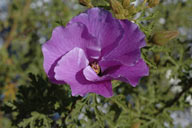Information about plants in flower this week
A news sheet prepared by a Gardens' volunteer, featuring the flowers, fruits and foliage of a selection of plants in
the Australian National Botanic Gardens .
Numbers before each plant refer to temporary IFTW labels in the gardens.
Numbers in square brackets [ ] refer to garden bed Sections. Featured plants are in bold type.
View past issues of 'In Flower This Week'.
6 July - 19 July 2016
Today we will walk up the hill behind the café, along the road behind the Rock Garden and finish on the Main Path.
- Grevillea rosmarinifolia ‘Scarlet Sprite’ [Section 174] on your right is just coming into bloom with bright red clusters of flowers on a neat bush of fine green foliage.
- On your left up high is Alyogyne huegelii ‘West Coast Gem’ [Section 210] with clear purple ‘hibiscus’ style flowers which open for a short period only but are prolific. The bush is medium sized with coarse foliage.
- Leucopogon attenuatus [Section 174] is on your right in a pot with white fluffy flowers on sparse stems. It is a small shrub endemic to southwestern Western Australia (WA).
- Epacris impressa [Section 174]. a straggly bush with bright pink tubular flowers is also on your irght. The pink-flowered form seen here is often referred to as Pink Heath, and is the floral emblem of the state of Victoria. It is found in southern New South Wales (NSW), Victoria, South Australia (SA) and throughout Tasmania.
- Bear left up the hill behind the café. Grevillea rosmarinifolia ‘Rosy Posy’ [Section 128], on your right, is a compact bush with linear foliage and pendent racemes of pink and cream flowers. This cultivated variety of Grevillea rosmarinifolia was developed by Austraflora Nurseries for its exceptionally large racemes.
- Acmena smithii [Section 140] up the hill on your left is a small tree with a dense crown of shiny green leaves covered in clusters of pink berries. Acmena smithii is the best known member of the lilly pillies and is widespread in east coast rainforests from north Queensland to Victoria. It is also found on King Island. Now turn right along the road behind the Rock Garden.
- Chamelaucium ‘Cascade Brook’ [Section 17], or Geraldton Wax, is on your right - an open airy bush with masses of purplish-pink 5 petalled flowers with darker centres. The species from which this cultivated form was developed is endemic to Western Australia.
- Hakea obtusa [Section 20] further along the road still on your right, is a small tree with grey-green leathery foliage and dark pink powderpuff flowers along the branches. It is native to the southwest coast of WA between Albany and Esperance.
- Grevillea tripartita subsp. macrostylis [Section 22], on the right , is an open, rangy plant with dark green, prickly, three lobed foliage and large single red and cream flowers with long showy red styles. It is native to southern WA.
- Grevillea vestita [Section 22], also on the right, is a large open bush with many starbursts of white flowers. It is a shrub endemic to southwestern WA .
- Turn right down the hill, then right again onto the Main Path. Grevillea centrastigma [Section 26], on your left, is a small bush with soft lush foliage fringed with with white hairs. Pendent hard yellow/orange flowers open from greenish buds. It is endemic to the south west region of WA.
- Adenanthos x cunninghamii [Section 24], on your right is a small bush with soft swirling silver foliage.
- Isopogon asper [Section 26], on your left, is a shrub that is endemic to the southwest botanical province of WA, and first described by botanist Robert Brown in 1830. It is a small shrub with daisy-like yellow flowers with pink centres aging to pink all over.
- Grevillea wilsonii x tripartita [Section 26], on your right, is a tall, rangy bush with green prickly foliage and large pink/red spider flowers with red styles.
- Finally on your left is Grevillea trifida [Section 26] with grey-green three-part foliage and cream spider flowers with reddish buds. It is native to southwestern WA
Rosalind Walcott
![Director of National Parks [logo]](../../../../images/dnp_90px.gif)







